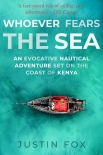Whoever Fears the Sea, Justin Fox [i love reading .TXT] 📗

- Author: Justin Fox
Book online «Whoever Fears the Sea, Justin Fox [i love reading .TXT] 📗». Author Justin Fox
No sooner had his feet touched the deck, than the sail was unfurled and Jamal put way on. Paul felt elated: Somalia beckoned, adventure beckoned. The baggage of the previous weeks could be left behind. This was his voyage now; the movie was only incidental. It was as though he’d crossed a boundary in himself. He stood on the quarterdeck beside Husni and waved at the blonde figure on the beach. Perhaps one day he could make a life with someone like her.
Jamal cleaved away from the shore, bending to a light breeze from the east-northeast. They cleared the headland and prepared to harden up into the wind. First the weatherside sharutis were tightened to give the mast better support, then Husni gave the command: ‘Kaza demani! Sheet in!’ Latif and Taki hauled on the mainsheet and the dhow heeled further over. Husni was at the tiller, pointing Jamal as high as she would go.
They sailed straight out to sea for an hour, the land diminishing to a smudge, until Husni decided to head back inshore and called for a gybe. Paul had been on board mashuas for wearing ship; now he could take careful note of how it was done on a jahazi. His Nikon was at the ready. The crew took up their positions as Husni bore away from the wind and Jamal wallowed exaggeratedly into a run. The sail flogged in thunderclaps as the foredeck team manhandled the yard into a vertical position, then twisted it around the front of the mast. At this precarious point in the manoeuvre, there were few ropes to control the sail. It was like trying to turn a circus tent inside out, without dismantling it, in a stiff breeze.
There was an awkward moment when the yard, standing vertical, bounced up and down like a battering ram, threatening to impale the deck or the men grappling with it. The crew tried desperately to keep the butt under control as clouds of sail ballooned around them. Agile Rafiki quickly carried the mainsheet around the front of the rig and trailed it aft. The yard was allowed to slide forward, back to its diagonal position, Husni gradually hardened up on the other tack and the flogging sail was brought under control. Jamal’s mainsheet was secured on the port side and water began to boil along the flanks again. The manoeuvre had been deftly handled and Paul had got some decent photographs.
Having left the archipelago’s ‘interior sea’ at Kiwayu, they remained outside the protecting kizingiti, the barrier reef that created a line of safe anchorages in its lee. The wind was warm and steady. Jamal drew a white chalk line through an azure sea. There was not another vessel in sight. Paul lay on the deck gazing up at the triangle of cotton and listening to the sound of creaking rope, the chafe of yard against mast, the happy splash of the bow wave and the murmur of the timbers. It sounded like a prayer, his own oceanic adhan.
A chain of calcareous islets stretched away to the north. Flocks of gulls and terns rained down on them like confetti. Many of the atolls were really just pieces of permanently dry reef. Local fishermen often mended their nets on these kiwas, or took overnight shelter there in makeshift bandas. Behind lay a low, uninhabited shore of mangrove swamps.
After lunch, they passed Kiungamini, the northernmost island in Kenya. ‘People call it Tanga la Mnara, place of the tower,’ said Husni, coming to sit beside Paul. ‘It’s got a tall pillar tomb. Look there! You can just make it out. Locals think it is the grave of an ifriti.’
‘What’s an ifriti?’
Husni explained that it was a dangerous jinni. The tomb was actually that of a British lieutenant murdered in the 1800s. In revenge, the Royal Navy attacked Kiungamini and destroyed everything. The locals abandoned the island for the mainland and built the tomb to appease the foreign ghost.
They sailed on in light airs, keeping well clear of a cluster of mushroom-shaped coral outcrops. Paul perched on the windward rail, shirt off, gazing over the bows and thinking about pirates and the anarchy of Somalia. Even the Chinese, sailing here many centuries ago, were terrified of this coast where humans could change themselves into birds, beasts or fish and strike the fear of death into travellers. If your commercial dealings with the Somalis went awry, sorcerers would cast a spell on your ship so it couldn’t be budged until the dispute, or rather the price, was settled.
Could the ruins found by the Hungarian archaeologist really be the famous port where Arab sailors came to barter metal tools for ivory and turtle shell? And who were its ancient inhabitants? Could they have been Bantu-speaking people from West Africa, as some historians suggested? For Paul, these questions were tantalising and the prospect of finding pre-Islamic ruins thrilling.
Ahead of them lay the promontory of Ras Kaambooni: Somalia. The wind had freshened and Jamal was creaming along handsomely. Flying fish broke the surface and glided through the air beside them like escorts. They were sailing closer to a shore that looked completely deserted. The green coastal fringe of Kenya had disappeared and the coast was barren, dominated in places by tall sand dunes. Inshore islets were covered with smaller dunes and bushy scrub. None bore any sign of humans.
Paul needed the toilet. There was no prospect of touching land for some time, so he was forced to use the open-top box that hung over the stern. He grabbed a roll of toilet paper and climbed inside. Jamal was sailing with an awkward, corkscrew motion and Paul found it hard to keep balance as he squatted over the hole. Aiming his buttocks at a gap that offered a window on to sluicing water was most unnerving. One moment he was centimetres from a dunking,





Comments (0)